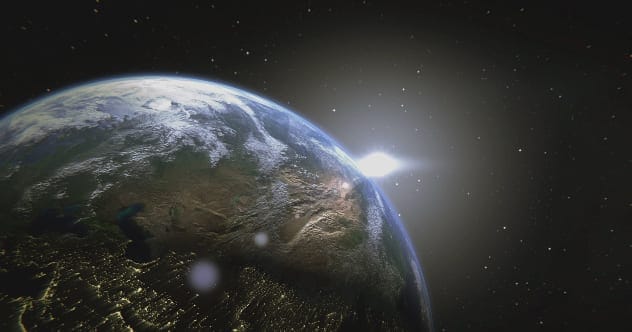The world is going to end. It might not be tomorrow, or next year, but eventually, things will go kaput. Whether it’s the end of human civilization, the demise of all life, or the literal disintegration of our planet, it’s all on the cosmic to-do list. The real question is: how will it happen?
Forget ancient prophecies and mystic predictions. Mainstream science has some pretty solid theories about the potential events that could bring about our world’s end. From tiny microbes to rogue space missiles, here are ten ways that scientists predict the world will end.
The Science of Doomsday: 10 Ways the World Could End
10 The Sun Turns on the Plants…
…and then the plants turn on us. The most accurate models predict that in about 600 million years, the sun will become bright enough to disrupt the carbonate-silicate cycle on Earth. This cycle maintains carbon dioxide levels in the atmosphere, so its disruption will cause those levels to plummet.
Plants won’t be able to photosynthesize, and they’ll stop producing the oxygen we need to breathe. Nearly all animal life, and most ecosystems, will go extinct. So, when plants turn on us, they won’t have a choice, but that won’t matter to the humans slowly suffocating. Or, maybe we’ll evolve into sentient gas monsters. Who knows?
9 Come, Comets
About 66 million years ago, a comet or asteroid wiped out 75% of all life on Earth, including the dinosaurs. And more comets/asteroids keep coming, sometimes getting unsettlingly close. In 2020, one named 2020 VT4 passed just 230 miles from Earth!
Asteroids usually come from the asteroid belt beyond Mars, but comets come from farther away, picking up speed. These ‘dirty snowballs’ are hard to detect because they’re very dark. If one big enough—just tens of miles across—hits the Earth, humans will go the way of the dinosaurs.
8 A.I. (Advanced Incineration)
Humans might not survive long enough to see a planet-shattering collision. We might not even make it past a couple of decades! Many scientists and futurists believe the culprit will be Terminators. The term ‘technological singularity’ applies to scenarios where technological growth becomes uncontrollable, but the scariest is the ‘intelligence explosion.’
As soon as we create an artificial intelligence beyond our own, it can produce an even greater intelligence, and on and on until only physics prevents further progress. This would quickly make humanity obsolete or worse—troublesome pests that need exterminating.
7 Ye Olde Malthusian Catastrophe
In 1798, Thomas Malthus argued that our population will rise faster than our food production. This will trigger starvation, global conflict, and population collapse, wherein most humans perish. This event is known as a Malthusian Catastrophe.
Since Malthus’s time, the human population has exploded, and billions of people live in constant starvation. Whether or not a worldwide collapse will occur, many can’t view food as a guarantee, and there are more each year.
6 Gamma Burst, i.e., Planet Hulk
Gamma-ray bursts are the brightest electromagnetic events ever detected in the universe. These intense explosions happen when a supermassive star implodes to form a black hole or neutron star, or when two neutron stars collide. They give off so much energy that, in seconds, they match the sun’s entire energy output over its lifetime.
Luckily, we’ve only witnessed gamma-ray bursts in other galaxies. However, many scientists think a gamma-ray burst is a possible culprit for the Late Ordovician mass extinction. If that were to happen again… well, hopefully, it would just create a planet of Hulks.
5 A Super-eruption
We don’t mean a Van Halen solo. A volcanic super-eruption attains the ‘super’ title if it spews at least 240 cubic miles of volcanic material. According to the Geological Society: “It’s not a question of ‘if’ – it’s a question of ‘when…’”
There are over 60 known to have occurred, each potentially causing species-level extinctions and mini ice ages. Though not much of a threat in our lifetime, Yellowstone might undo many Americans and Canadians in a few thousand years.
4 Diatoms, Emphasis on the Die
Diatoms are algae famous for their colorful, geometric cell walls. They produce up to half the oxygen on the planet each year and constitute up to half the biomass in our oceans. They’re a big deal. Thus, it would be bad if they started acting differently.
Joe Kirschvink, a Caltech geobiologist, raised the concern that, if climate change causes diatoms to lose access to water (which they use to produce oxygen), they might switch to salt, producing deadly chlorine gas. Given their numbers, this could quickly kill off most life on Earth.
3 Stable Orbit, Schmable Schmorbit
Earth’s orbit around the sun isn’t stable. Over the planet’s lifetime, it has changed and will continue to change until the end. The change may even cause that end itself. Worse, a change in any other planet’s orbit could do the same.
Jupiter’s massive gravity pulls on planets and other bodies. It can be extremely helpful, such as when the planet sucks up asteroids. But it can also lead to disaster. Jupiter might one day pull so hard on Mercury that the little rock could smash into the sun, Venus, or even Earth.
2 Fungus Among… Our Graves
Not just a plot device for “Last of Us,” a worldwide fungal pandemic is entirely possible. One particular genus of fungus, Cordyceps, causes a sort of zombification of their host animals. Another group, the chytrids, is contributing to the extinction of all frog species.
Fungal diseases are relatively unstudied when compared to bacterial and viral diseases, and look at the millions who died from one of those. Whether it’s actual zombies or just a slow, painful death, fungal diseases are anything but ‘fun.’
1 The Snowball, i.e., The Whole List at Once
Easily the scariest of all is when about half of these happen at once. Even worse is that most scientists tend to think that is what will happen and soon.
Climate change will have a huge effect on weather patterns, making them gradually more erratic and extreme. At the same time, increasing average temperatures will make many disease-causing microbes more common. Many plants and pollinator species, such as bees and bats, will have died (the bats by another fungal disease), making food more scarce as populations continue to grow. Ocean acidification and pollution will decrease the number of photosynthesizers there, and many other ecosystems will be thrown into disarray. Overall, the nearest and most likely end of the world is a slow, subtle, multi-pronged attack by… us.
So, there you have it: ten scientifically plausible ways the world could end. Cheerful, isn’t it? But hey, at least you’re informed. Now, if you’ll excuse me, I’m going to go build a bunker.
What do you think is the most likely way the world will end? Leave your comment below!










